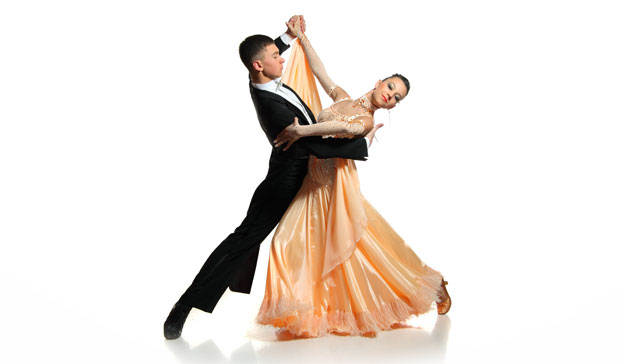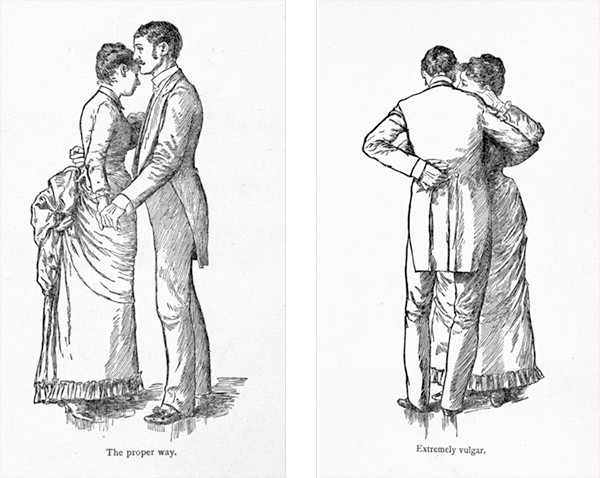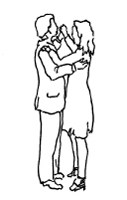Waltz
From Londonhua WIKI
Waltz
 | |
| Waltz Frame | (Stylized) |
|---|---|
Overview
Waltz is a modern Ballroom Dance, first appearing in England in the early 19th century [1]. Waltz has appeared widely in films and the popular media, and is often the form of dance most closely associated with the Ballroom category.
Contents
Background
Waltz is the oldest modern Ballroom Dance[2], having been introduced to the English ballroom in 1812[3]. The name of the dance comes from the German "waltzen," meaning "to revolve[4]." This name describes the primary movement style of the dance, in which couples constantly turn and revolve as they make their way around the line of dance[5]. The waltz is danced in 3/4 time[6].
Technique
Many varieties of waltz exist, as detailed in the "Varieties of Waltz" section. The most common variety, though, is known as International Waltz or Standard Waltz. In its most basic form, Standard Waltz is characterized by closed hold frame and the Closed Change step patterns. Throughout all of its figures and steps, Standard Waltz is recognizable for its smooth, sliding grace and its rise-and-fall movements.
Closed Hold
In closed frame for Standard Waltz, and in most other varieties of waltz, the leader places his right hand on the follower's left shoulder blade, with the side of his thenar and wrist crease against the back of her armpit. The follower places her left hand on the leader's upper arm, near the shoulder. The leader's left arm is raised to slightly lower lower than shoulder-height, and the elbow is bent sharply to extend the hand upward. The follower reflects this position with her right arm, wrapping her fingers around the leader's hand between the thumb and fingers. The couple then spreads their elbows wide to the side, maintaining light body contact with the follower slightly to the right of the leader's center.The leader and follower both look over their respective left shoulders[7].
Closed Changes
The Closed Changes, known separately as the Left Closed Change and the Right Closed Change, are the most fundamental steps of Standard Waltz, and of most other forms of waltz, as well.
Left Closed Change
For Leaders: At the beginning of this step, the leader's body weight is entirely on his right foot. First, he steps forward with his left foot on the count of one, steps diagonally forward with his right foot on the count of two, and finally closes his feet and changes his weight to his left foot on the count of three.
For Followers: Mirroring the leader, the follower begins this step with her weight on her left foot. She steps backwards with her right foot on the count of one, steps diagonally backwards with her left foot on the count of two, and closes her feet and changes her weight to her right foot on the count of three.
Right Closed Change
For Leaders: For this step, the leader begins with his weight on his left foot. He then steps forward with this right foot on the count of one, steps diagonally forward with his left foot on the count of two, and finishes by closing his feet and changing his weight to his right foot on the count of three.
For Followers: The follower begins with her weight on her right foot, then steps backwards with her left foot on the count of one, steps diagonally backwards with her right foot on the count of two, and closes her feet and changes her weight to her left foot on the count of three.
History
Introduction to England
Up until the introduction of Waltz into the English ballroom scene in 1812, social dancing in England had largely been dominated by forms of contra dancing[8]. These styles were typified by minimal body contact and the regular changing of partners[9]. This form of social dancing had been the main feature of English ballrooms for hundreds of years, so the Waltz, with its close frame, body contact, and constant turning, came as a shock[10].
Waltz's entrance into England is traced to a single dance club in London. Almack's Assembly Rooms, located in the heart of St. James's on King Street, was an elite ballroom that reached a peak during the Regency. Here, members of London's fashionable elite would gather for Wednesday evening balls, often as a way to search for matchmaking opportunities[11]. In fact, Almack's was "notorious" as a "marriage market" for debutantes[12]. When Waltz was introduced into this charged social scene, it instantly became both popular and notorious[13]. Because the hold for waltz was so close and sustained, it was interpreted as highly lascivious. Lord Byron was among the early skeptics, having seen the waltz performed soon after its introduction. He anonymously published a poem to express his thoughts, appearing in 1813 and titled, "Waltz: An Apostrophic Hymn[14]." The following is an excerpt.
Waltz—Waltz—alone both legs and arms demands,
Liberal of feet—and lavish of her hands;
Hands which may freely range in public sight,
Where ne’er before—but—pray ‘put out the light.’
Methinks the glare of yonder chandelier
Shines much too far—or I am much too near;
And true, though strange—Waltz whispers this remark;
'My slippery steps are safest in the dark!' [15]
In fairness, this opinion may not have been entirely unfounded. There are reports that couples, while waltzing through the darker corners of ballrooms, would sometimes engage in "bolder embraces and kisses[16]."
Perhaps because of Byron's scathing poem, waltz was slow to spread through the elite ballrooms of London[17]. It did, however, quickly move through the lower levels of society, where it rapidly became popular[18]. Interestingly, Waltz seems to have passed directly from the lower classes to the English Royalty, bypassing the disapproving upperclass. Waltz was included in a royal ball in 1816, the Regent's Fête[19]. The following is the reaction from the London Times.
We remark with pain that the indecent foreign dance called the Waltz was introduced (we believe, for the first time) at the English Court on Friday last. This is a circumstance which ought not to be passed over in silence. National morals depend on national habits: and it is quite sufficient to cast one’s eyes on the voluptuous intertwining of the limbs, and close compressure of the bodies, in this dance, to see that it is far indeed removed from the modest reserve which has hitherto been considered distinctive of English females. So long as this obscene display was confined to prostitutes and adulteresses, we did not think it deserving of notice; but now that it is attempted to be forced on the respectable classes of society by the evil example of their superiors, we feel it a duty to warn every parent against exposing his daughter to so foul a contagion. Amicus Plato sed mogis amica veritas. We pay a due deference to our superiors in rank, but we owe a higher duty to morality. We know not how it has happened (probably by the recommendation of some worthless and ignorant French dancing-master) that so indecent a dance now has for the first time been exhibited at the English court; but the novelty is one deserving of severe reprobation, and we trust it will never again be tolerated in any moral English society.[20]
This protest proved ineffective. "Waltz mania[21]" quickly infected the nation, gaining particular popularity with the working and middle classes, who would practice at public dance halls[22]. Indeed, by 1852, even the Royal Family was being tutored in the Waltz. According to their instructor, Joseph Lowe, Queen Victoria herself was an admirer of the dance, and took full advantage of his lessons. To her regret, though, Queen Victoria could seldom practice the Waltz in public because it was considered "undignified for the Sovereign to dance in the arms of a subject[23]."
Waltz in the 20th Century
 | |
| "The Proper Way" and "Extremely Vulgar," as described in Allan Dodworth's 1900 dance manuel | |
|---|---|
| Credit: | Allen Dodworth[24] |
Waltz continued to grow in popularity through the late 19th and early 20th centuries, gaining in both legitimacy and formality[25]. It is worth noting that the early hold for Waltz was far more relaxed than it is today[26]. For instance, in early Waltz, the leader's left arm was lowered, and his right arm was wrapped low around the follower's back[27]. This contrasts sharply with the more modern hold illustrated in the "Technique" section above. This change in frame was likely caused by the shift in the role of Waltz on the dancefloor in the early 20th century.
Waltz had become the primary social dance in England by the mid-19th century, and retained this honor until World War I[28]. The first dance to surpass Waltz in popularity was the Foxtrot, which "crept in, like a cat, from America[29]" just before World War I[30]. The Foxtrot was premiered by famous exhibition dancers Vernon and Irene Castle, and boomed in popularity during the War[31]. By 1911, rag music and jazz had both arrived in England from America, and were inspiring new rhythmic dances like the Onestep, the Twostep, Quickstep, and many others[32]. Many of these dances were far more salacious than the Waltz, and quickly displaced it as the social dances of choice[33]. However, unlike many other older dances, Waltz did not disappear. Instead, it moved into more formal settings and into Ballroom competitions. In order to adapt to this changed setting, Waltz became far more regimented and formally defined[34]. During this process, the Waltz frame was developed to have a more regal appearance, reflecting its new position as the primary formal ballroom dance[35]. This remains the place of Waltz to the present day.
Varieties of Waltz
Over time, waltz has evolved into many differentiated styles. These styles include:
- American/Smooth Waltz - This style is characterized by an optional open frame, allowing dancers to complete complex patterns with only one hand or no hands touching[36].
- International/Standard Waltz - This style is known for its closed hold and highly standardized movements. This form of Waltz is the most common form to be danced in Ballroom competitions around the world[37].
- Viennese Waltz - Unlike for other forms of Waltz, the tempo for Viennese Waltz is nearly two hundred beats per minute. This is nearly twice the tempo used in other forms. Closed hold is less strict in Viennese Waltz than in Standard Waltz, allowing dancers to perform underarm turns and other figures in open hold or shadow position. Because of its rapid pace, Viennese Waltz has less rise and fall and less sway than do other forms of Waltz[38].
- Country Western Waltz - This style is danced at a tempo slightly slower than Viennese Waltz and includes many of the open hold characteristics of American Waltz. However, Country Western Waltz makes greater use of shadow position and running progressive steps than other styles[39]. Country Western Waltz is mainly restricted to social atmospheres, seldom appearing in competitions.
In Popular Culture
Because Waltz is the oldest modern Ballroom Dance, it is arguably also the dance most closely associated with the Ballroom style of dance[40]. Despite its origins as the most erotic dance of the Victorian era[41], Waltz today is mainly thought of in the context of ball gowns, manners, and high society[42]. This impression is reinforced by the place of Waltz as one of the most popular First Dances at weddings[43]. While Waltz is sometimes thought of as outdated, Waltz music continues to be produced, as in Bruno Mars' 2012 "If I Knew" and Norah Jones' 2001 "Come Away With Me." Waltz is regularly featured in popular televised dance competitions such as "Dancing With the Stars[44]."
References
- ↑ T. (n.d.). Waltz: Dance. Retrieved May 10, 2017, from https://www.britannica.com/art/waltz
- ↑ Waltz. (n.d.). Retrieved May 10, 2017, from https://www.americandancesportcenter.com/waltz
- ↑ Wilson, C. A. (n.d.). The Arrival of the Waltz in England, 1812. BRANCH. Retrieved May 9, 2017, from http://www.branchcollective.org/?ps_articles=cheryl-a-wilson-the-arrival-of-the-waltz-in-england-1812
- ↑ T. (n.d.). Waltz: Dance. Retrieved May 10, 2017, from https://www.britannica.com/art/waltz
- ↑ Waltz. (n.d.). Retrieved May 10, 2017, from https://www.americandancesportcenter.com/waltz
- ↑ Waltz. (n.d.). Retrieved May 10, 2017, from https://www.americandancesportcenter.com/waltz
- ↑ Ballroom Dance Holds. (n.d.). Retrieved May 10, 2017, from http://waltz-dance.com/ballroom-dance-holds.html
- ↑ Wilson, C. A. (n.d.). The Arrival of the Waltz in England, 1812. BRANCH. Retrieved May 9, 2017, from http://www.branchcollective.org/?ps_articles=cheryl-a-wilson-the-arrival-of-the-waltz-in-england-1812
- ↑ Contra Dance - History of Contra Dancing. (n.d.). Retrieved May 10, 2017, from http://www.dancefacts.net/dance-list/contra-dance/
- ↑ Wilson, C. A. (n.d.). The Arrival of the Waltz in England, 1812. BRANCH. Retrieved May 9, 2017, from http://www.branchcollective.org/?ps_articles=cheryl-a-wilson-the-arrival-of-the-waltz-in-england-1812
- ↑ Wilson, C. A. (n.d.). The Arrival of the Waltz in England, 1812. BRANCH. Retrieved May 9, 2017, from http://www.branchcollective.org/?ps_articles=cheryl-a-wilson-the-arrival-of-the-waltz-in-england-1812
- ↑ Wilson, C. A. (n.d.). The Arrival of the Waltz in England, 1812. BRANCH. Retrieved May 9, 2017, from http://www.branchcollective.org/?ps_articles=cheryl-a-wilson-the-arrival-of-the-waltz-in-england-1812
- ↑ Wilson, C. A. (n.d.). The Arrival of the Waltz in England, 1812. BRANCH. Retrieved May 9, 2017, from http://www.branchcollective.org/?ps_articles=cheryl-a-wilson-the-arrival-of-the-waltz-in-england-1812
- ↑ Wilson, C. A. (n.d.). The Arrival of the Waltz in England, 1812. BRANCH. Retrieved May 9, 2017, from http://www.branchcollective.org/?ps_articles=cheryl-a-wilson-the-arrival-of-the-waltz-in-england-1812
- ↑ Hornem, H., Esq. (1821). Waltz: An Apostrophic Hymn. W. Clark.
- ↑ Gronow, R. H. (1892). The Reminiscences and Recollections of Captain Gronow: Being Anecdotes of the Camp, Court, Clubs, and Society 1810-1860. London: John C. Nimmo.
- ↑ Wilson, C. A. (n.d.). The Arrival of the Waltz in England, 1812. BRANCH. Retrieved May 9, 2017, from http://www.branchcollective.org/?ps_articles=cheryl-a-wilson-the-arrival-of-the-waltz-in-england-1812
- ↑ Hornem, H., Esq. (1821). Waltz: An Apostrophic Hymn. W. Clark.
- ↑ Wilson, C. A. (n.d.). The Arrival of the Waltz in England, 1812. BRANCH. Retrieved May 9, 2017, from http://www.branchcollective.org/?ps_articles=cheryl-a-wilson-the-arrival-of-the-waltz-in-england-1812
- ↑ Wilson, C. A. (n.d.). The Arrival of the Waltz in England, 1812. BRANCH. Retrieved May 9, 2017, from http://www.branchcollective.org/?ps_articles=cheryl-a-wilson-the-arrival-of-the-waltz-in-england-1812
- ↑ Wilson, C. A. (n.d.). The Arrival of the Waltz in England, 1812. BRANCH. Retrieved May 9, 2017, from http://www.branchcollective.org/?ps_articles=cheryl-a-wilson-the-arrival-of-the-waltz-in-england-1812
- ↑ Russell, M. (n.d.). The History of Ballroom Dancing. Retrieved May 11, 2017, from http://www.montrealballroomdancing.com/2011/07/the-history-of-ballroom-dancing/
- ↑ Russell, M. (n.d.). The History of Ballroom Dancing. Retrieved May 11, 2017, from http://www.montrealballroomdancing.com/2011/07/the-history-of-ballroom-dancing/
- ↑ Dodworth, A. (1900). Dancing and its Relation to Education and Social Life. New York and London: Harper & Brothers.
- ↑ A History of the Development of Ballroom Dancing in the U.K. 1918-1939. (n.d.). Retrieved May 11, 2017, from http://www.wellingtonschoolofdance.co.uk/a-history-of-the-development-of-ballroom-dancing-in-the-uk-1918-1939
- ↑ Dodworth, A. (1900). Dancing and its Relation to Education and Social Life. New York and London: Harper & Brothers.
- ↑ Dodworth, A. (1900). Dancing and its Relation to Education and Social Life. New York and London: Harper & Brothers.
- ↑ A History of the Development of Ballroom Dancing in the U.K. 1918-1939. (n.d.). Retrieved May 11, 2017, from http://www.wellingtonschoolofdance.co.uk/a-history-of-the-development-of-ballroom-dancing-in-the-uk-1918-1939
- ↑ A History of the Development of Ballroom Dancing in the U.K. 1918-1939. (n.d.). Retrieved May 11, 2017, from http://www.wellingtonschoolofdance.co.uk/a-history-of-the-development-of-ballroom-dancing-in-the-uk-1918-1939
- ↑ A History of the Development of Ballroom Dancing in the U.K. 1918-1939. (n.d.). Retrieved May 11, 2017, from http://www.wellingtonschoolofdance.co.uk/a-history-of-the-development-of-ballroom-dancing-in-the-uk-1918-1939
- ↑ A History of the Development of Ballroom Dancing in the U.K. 1918-1939. (n.d.). Retrieved May 11, 2017, from http://www.wellingtonschoolofdance.co.uk/a-history-of-the-development-of-ballroom-dancing-in-the-uk-1918-1939
- ↑ A History of the Development of Ballroom Dancing in the U.K. 1918-1939. (n.d.). Retrieved May 11, 2017, from http://www.wellingtonschoolofdance.co.uk/a-history-of-the-development-of-ballroom-dancing-in-the-uk-1918-1939
- ↑ A History of the Development of Ballroom Dancing in the U.K. 1918-1939. (n.d.). Retrieved May 11, 2017, from http://www.wellingtonschoolofdance.co.uk/a-history-of-the-development-of-ballroom-dancing-in-the-uk-1918-1939
- ↑ History of Waltz. (n.d.). Retrieved May 11, 2017, from http://www.centralhome.com/ballroomcountry/waltz.htm
- ↑ Miller, G. (n.d.). The History of the Waltz. Retrieved May 11, 2017, from http://dance.lovetoknow.com/history-dance/history-waltz
- ↑ Wells, P. (n.d.). The Different Styles of Waltz Dancing. Retrieved May 10, 2017, from http://www.dancetime.com/waltz-dance-styles-1835/
- ↑ Wells, P. (n.d.). The Different Styles of Waltz Dancing. Retrieved May 10, 2017, from http://www.dancetime.com/waltz-dance-styles-1835/
- ↑ Wells, P. (n.d.). The Different Styles of Waltz Dancing. Retrieved May 10, 2017, from http://www.dancetime.com/waltz-dance-styles-1835/
- ↑ Wells, P. (n.d.). The Different Styles of Waltz Dancing. Retrieved May 10, 2017, from http://www.dancetime.com/waltz-dance-styles-1835/
- ↑ Waltz. (n.d.). Retrieved May 10, 2017, from https://www.americandancesportcenter.com/waltz
- ↑ Wilson, C. A. (n.d.). The Arrival of the Waltz in England, 1812. BRANCH. Retrieved May 9, 2017, from http://www.branchcollective.org/?ps_articles=cheryl-a-wilson-the-arrival-of-the-waltz-in-england-1812
- ↑ Tsioulcas, A. (2014, June 18). A Rhythm That Has Waltzed Away With Hearts. Retrieved May 14, 2017, from http://www.npr.org/sections/deceptivecadence/2014/06/18/322930952/a-rhythm-thats-waltzed-away-with-hearts.
- ↑ The History Behind The First Dance. (2015, March 10). Retrieved May 14, 2017, from http://windycityweddingdance.com/history-behind-first-dance
- ↑ Tsioulcas, A. (2014, June 18). A Rhythm That Has Waltzed Away With Hearts. Retrieved May 14, 2017, from http://www.npr.org/sections/deceptivecadence/2014/06/18/322930952/a-rhythm-thats-waltzed-away-with-hearts.

